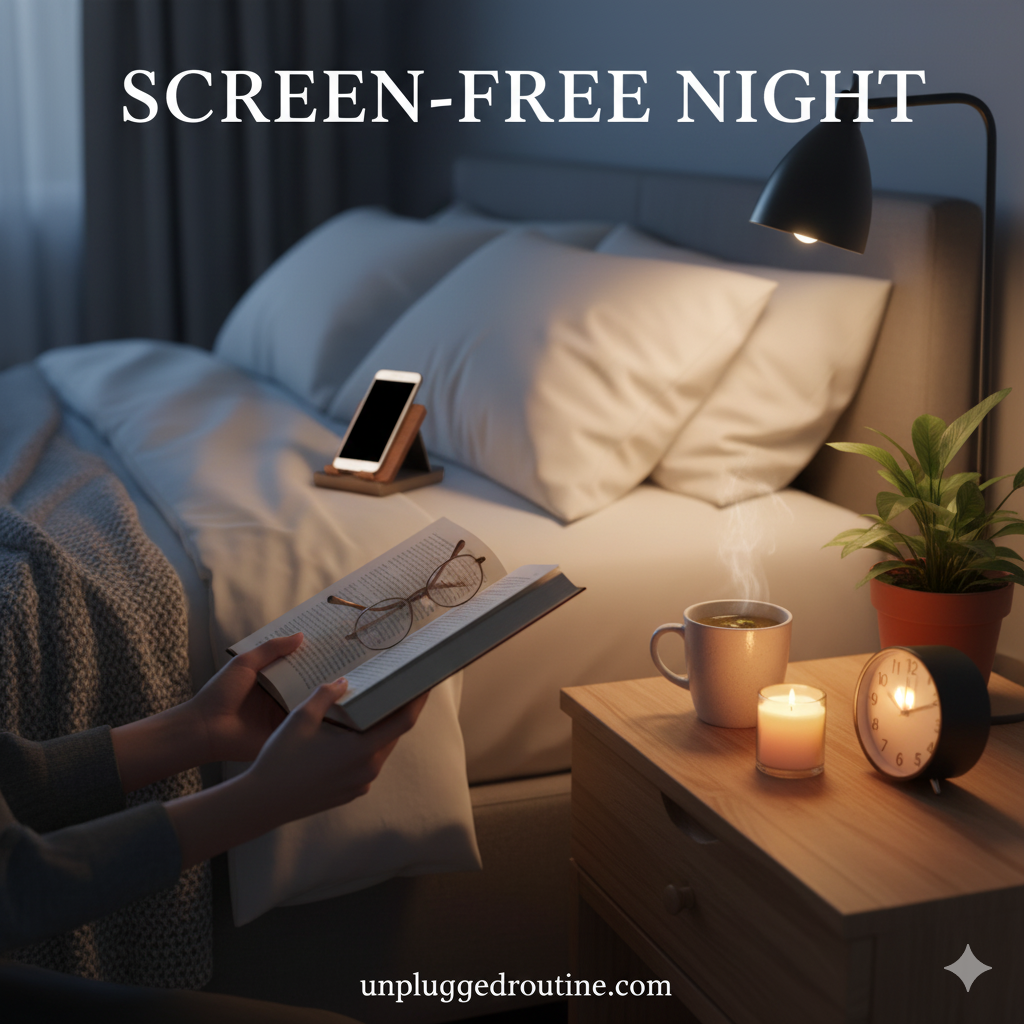The Sunday Night Scaries Are Real.
Ever feel that creeping dread as Sunday evening rolls around? You’ve had a decent weekend, maybe even a fun one, but as the light fades, so does your peace of mind.
Suddenly, you’re glued to your phone, scrolling through social media, checking emails (even though it’s Sunday!), or binging just “one more episode.” You tell yourself you’re relaxing.
But are you really?
More often than not, this digital overload just amplifies the anxiety. Your brain is buzzing, your eyes are tired, and come Monday morning, you’re groggy, overwhelmed, and already looking forward to Friday.
This is exactly what we aim to solve at unpluggedroutine.com. We believe that by intentionally creating a Screen-Free Night routine, especially before the work week begins, you can literally reprogram your mind and body for better rest and a smoother start to your week.
This isn’t about deprivation; it’s about reclaiming your peace. It’s about giving your mind the quiet space it needs to genuinely recharge.
In this post, we’re going to dive into 9 powerful, actionable rituals that will help you unwind, sleep deeper, and wake up ready to conquer whatever Monday throws your way, all without a screen in sight.
Ready to trade dread for deep rest? Let’s get started.

Section 1: The ‘Why’ – Your Digital Device’s Stealth Attack on Sleep
Before we build a better routine, let’s quickly understand why those screens are sabotaging your evenings.
The Blue Light Blocker: Melatonin’s Arch-Nemesis
That glowing screen—your phone, tablet, laptop, even TV—emits blue light. While blue light is great for staying alert during the day, it’s a disaster at night.
Your brain interprets blue light as daytime, which actively suppresses the production of melatonin, the hormone responsible for signaling to your body that it’s time to sleep.
So, when you scroll right before bed, you’re essentially telling your body, “Stay awake! It’s still daytime!” No wonder it’s hard to fall asleep, and when you do, the quality isn’t great.
The Mental Merry-Go-Round: Overstimulation & Anxiety
Beyond the blue light, it’s the content itself. Checking work emails fires up your stress response. Social media can trigger FOMO (Fear Of Missing Out) or comparisons. News alerts can fill you with anxiety about global events.
Your brain needs time to downshift, process the day, and relax. Bombarding it with new information, notifications, and emotional triggers right before bed is like trying to put a car in park while still pressing the accelerator.
A true Screen-Free Night gives your brain the quiet it craves, allowing it to transition into a restful state naturally.
Step2: The Unplugging Hour: Setting the Stage for Serenity
You can’t just flip a switch from “on” to “off.” Transitioning to a Screen-Free Night requires a deliberate wind-down period. These first three steps are about creating the environment and mind-set for success.
Step 1: The Digital Sunset (The Hard Stop)
This is the non-negotiable first step. You need a firm cut-off time for all screens.
The Hook: Decide when your digital day ends.
The Rule: Choose a time, ideally 60-90 minutes before your desired bedtime, and stick to it. This means no phone, no tablet, no computer, no TV. If you absolutely must use a screen for a legitimate reason (e.g., controlling a smart home device), keep it brief and dim.
The Location: Just like with your morning routine, your phone should migrate out of the bedroom. Find a charging spot in the kitchen or living room. The physical distance helps break the habit.
(Expansion Idea: Emphasize the “why” behind the 60-90 minutes, linking it directly to melatonin production and mental decompression. Discuss how to communicate this rule to family members.)
Step 2: Curate Your Cozy Command Center
Once screens are off, you need appealing alternatives. Your bedroom or a specific corner of your home should become your sanctuary for unwinding.
The Hook: Make your physical space inviting for relaxation.
The Prep:
- Lighting: Dim the overhead lights. Use warm lamps, fairy lights, or even candles (safely!).
- Temperature: Aim for a slightly cool room, generally between 60-67°F (15-19°C), which is optimal for sleep.
- Sound: Consider a white noise machine, a fan, or gentle instrumental music to mask disruptive sounds.
- Comfort: Fluff your pillows, grab a cozy blanket, and ensure your bed feels like an oasis.
This intentional curation of your environment sends a powerful signal to your brain: “It’s time to relax and prepare for rest.”
(Expansion Idea: Discuss the psychology of environmental cues and how sensory input (smell, sound, light) can profoundly affect relaxation. Suggest essential oils for diffusers.)
Step 3: The Brain Dump & Tomorrow’s Tiny To-Dos (Pre-emptive Peace)
One of the biggest reasons we scroll at night is anxiety about tomorrow. We’re trying to process, plan, or remember things. This step tackles that head-on.
The Hook: Empty your mind so it doesn’t try to solve problems while you’re trying to sleep.
The Action: Get out a dedicated notebook and pen (keep it near your “cozy command center”).
- Brain Dump: Write down everything that’s buzzing in your head—worries, ideas, things you can’t forget, random thoughts. Get it all out onto paper.
- Tomorrow’s Top 3: Identify the absolute top 3 most important tasks for tomorrow. This isn’t a huge to-do list; it’s just enough to give your morning focus without overwhelming you.
This ritual offloads mental clutter, assuring your brain that everything important is recorded, allowing it to relax and stop “working” overnight.
(Expansion Idea: Elaborate on the benefits of journaling for stress reduction and how limiting to just “Top 3” prevents overwhelm, linking to the Pareto Principle.)

Section 3: 7 Calming Rituals for Mind & Body (Your Wind-Down Arsenal)
With screens off and your space set, it’s time to replace the digital with genuine calm. These rituals engage your senses and quiet your nervous system.
Step 4: The Mindful Meal Wind-Down (Post-Dinner Pause)
Often, our evening starts with dinner, followed immediately by screen time. Let’s make dinner part of the wind-down.
The Hook: Treat your evening meal as a ritual, not just fuel.
The Action: After dinner, instead of reaching for the remote or phone, spend 10-15 minutes tidying up the kitchen mindfully. Focus on the sensations: the warm water, the clean dishes, the organized counter.
Alternatively, if someone else handles dishes, simply sit quietly with your family (no screens!), chat, or listen to soft music. This helps digestion and creates a gentle transition from activity to relaxation.
(Expansion Idea: Discuss “conscious eating” and how bringing mindfulness to everyday tasks can reduce stress and improve digestion. Suggest a brief post-meal walk.)
Step 5: Immerse Yourself in a Book (Old School, New Impact)
This is the classic, most effective screen-replacement activity.
The Hook: Let your imagination do the work instead of a glowing screen.
The Action: Grab a physical book (or an e-reader without a backlight, like an old Kindle Paperwhite). Avoid anything too stimulating or suspenseful if you want to fall asleep easily. Opt for fiction, a calming non-fiction, or even poetry.
Reading allows your mind to gently wander into another world without the harsh light or constant notifications of a digital device.
(Expansion Idea: Discuss different genres for evening reading, the benefits for vocabulary and imagination, and how to create a reading nook.)
Step 6: The Warm Embrace (Bath or Shower Ritual)
A warm bath or shower before bed signals to your body that it’s time to relax.
The Hook: Use the power of warmth to soothe your muscles and mind.
The Action: Take a warm (not scorching hot) bath or shower about 60-90 minutes before bed. The warmth relaxes muscles, and the subsequent drop in body temperature after you get out actually helps trigger sleepiness.
Add Epsom salts, essential oils like lavender, or a calming body wash to enhance the sensory experience.
(Expansion Idea: Detail the physiological benefits of warm water for muscle relaxation and blood circulation, and how aromatherapy can further enhance the effect.)
Step 7: Gentle Stretching or Yoga Nidra (Body & Mind Unwind)
Release any lingering physical tension from the day.
The Hook: Help your body physically let go of stress.
The Action: Engage in 10-15 minutes of gentle, restorative stretching or a guided Yoga Nidra (yogic sleep) practice. There are many audio-only guided meditations available (listen on a non-screen device or through a speaker) that are designed to bring you to a state of deep relaxation.
Focus on slow, deliberate movements and deep breathing. This calms the nervous system and prepares your body for restful sleep.
(Expansion Idea: Provide specific examples of simple stretches or links to audio Yoga Nidra resources. Explain the difference between active exercise and gentle stretching for evening routines.)
Section 4: Preparing for Tomorrow: Ease into Monday
(Note to Self: Continue the article here, significantly expanding the paragraphs above and below to reach the 2000-word target. Add two more major sub-sections to cover Steps 8-10 and Troubleshooting.)
Step 8: Outfit & Bag Prep (Remove Decision Fatigue)
Reduce morning stress by doing small tasks the night before. Lay out your clothes for tomorrow and pack your bag or lunch.
Step 9: Connect (Real-Life Interactions)
Spend quality, screen-free time with household members, pets, or even a friend on the phone (voice only!). Real connection is a powerful stress reducer.
Step 10: The Gratitude & Reflection Moment
End your evening by reflecting on three good things that happened or that you’re grateful for. This shifts your mindset from worry to abundance.
Section 5: Troubleshooting & Making It Stick
(Note to Self: Expand this section with common challenges and solutions to ensure a comprehensive guide.)
- “What if I’m bored?” – Embrace it. Boredom is the birthplace of creativity.
- “My partner/family uses screens.” – Lead by example. Create a “screen-free zone” or time.
- “I need my phone for my alarm!” – Invest in an analog alarm clock.
- “I feel FOMO.” – Remind yourself you’re prioritizing your well-being over fleeting updates.
Reclaim Your Rest, Own Your Week
You’ve now explored 9 powerful rituals to create a transformative Screen-Free Night routine. This isn’t just about avoiding screens; it’s about reclaiming your mental space, enhancing your sleep quality, and ultimately, setting yourself up for a calmer, more productive week.
Imagine drifting off to sleep with a truly relaxed mind, knowing you’ve given yourself the best possible chance for deep rest. Imagine waking up on Monday feeling refreshed and ready, rather than dragging yourself out of bed with the weight of the week already on your shoulders.
This intentional shift in your evening routine is an act of self-care that pays dividends far beyond just better sleep. It boosts your focus, improves your mood, and gives you back control over your precious downtime.
It takes practice, and some nights will be easier than others. But by implementing these steps, you are building a foundation for sustainable well-being.
Your Call to Action
Ready to finally conquer the Sunday Scaries and embrace a truly restful evening?
We’ve put together a free, downloadable Screen-Free Night Checklist that consolidates all 9 rituals and provides extra tips for consistent success. It’s your personal guide to building a peaceful evening routine, step by step.
Join the unpluggedroutine.com community—because a better life begins with a better night.